GainsightPX for Onboarding Automation: Features, Pricing, and Review
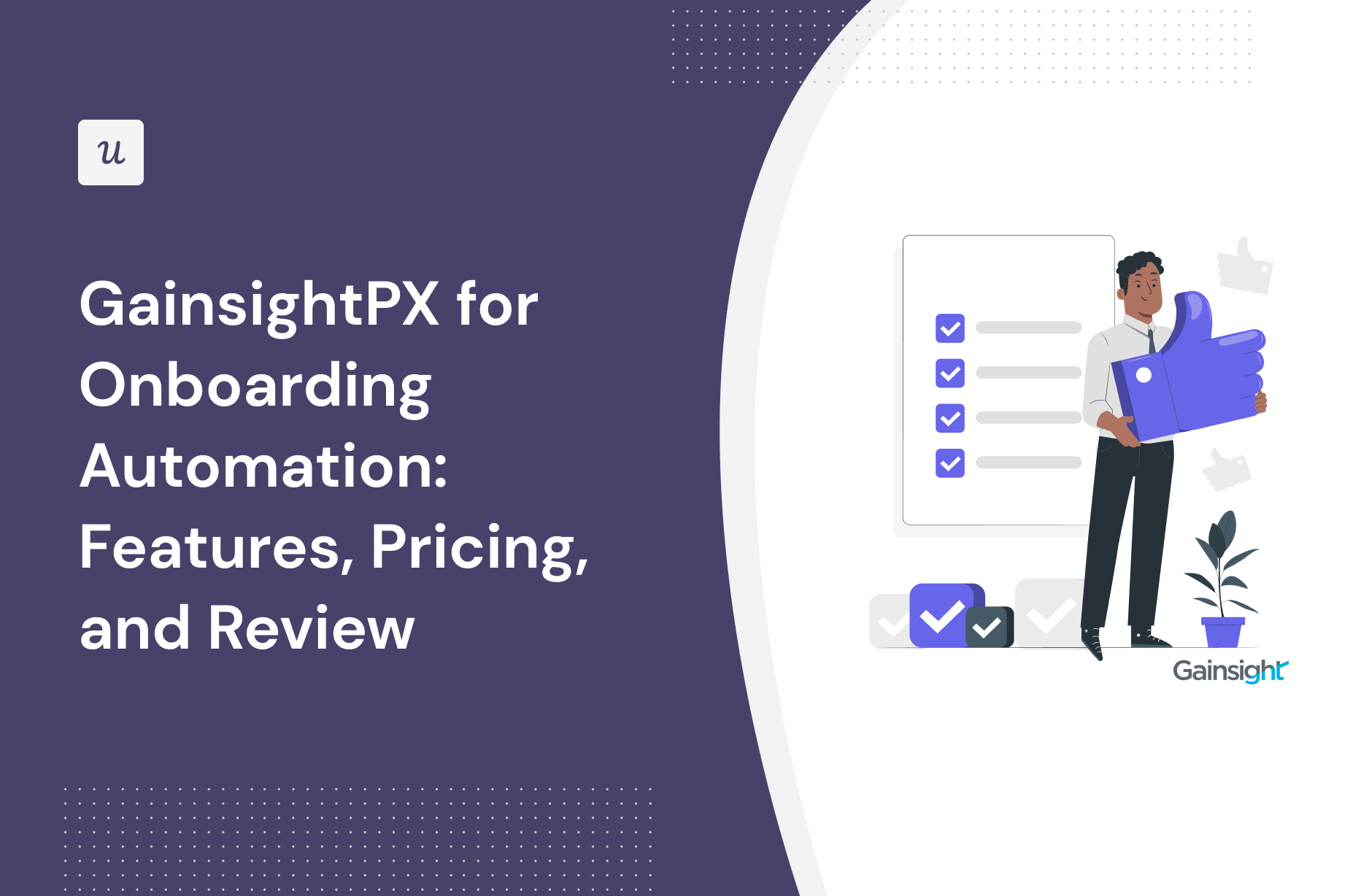
Looking for an effective onboarding automation tool and wondering if GainsightPX is the best option for your SaaS company?
With numerous GainsightPX alternatives, it can be challenging to make a final decision.
In this article, we’ll delve into precisely that – helping you determine whether GainsightPX is the ideal choice for your onboarding automation needs. We’ll explore its features, pricing, and offer a comprehensive review to aid in your decision-making process.
Let’s get started!
TL;DR
- GainsightPX is a good choice for onboarding automation and it comes with features such as user segmentation, onboarding checklist, self service support, and user journey mapping.
- GainsightPX is one of the most prominent product experience platforms in the market. However, it does have its fair share of flaws.
- Here are three main scenarios in which you would be better off choosing a GainsightPX alternative:
- You’re on a budget: GainsightPX isn’t the best option if you don’t have a big budget. While the pricing information is only available on request, it could cost you over $2500/month. This could be quite pricey if you’re on a budget and it’d be best to opt for a platform that’s more affordable.
- You want a more beginner-friendly platform: While GainsightPX does offer some beginner-friendly features like a WYSIWYG editor, it does have a long learning curve. If you have a non-technical background, you’re perhaps better off using a GainsightPX alternative.
- You need more extensive survey features: GainsightPX offers numerous types of surveys, including NPS. It also enables you to create multi-question survey engagements. But if you need more advanced features like behavior-based survey triggers and translations, you should opt for other platforms.
- If you’re looking for a better option for onboarding automation, Userpilot exceeds both functionality and value for money compared to GainsightPX
- Ready to see Userpilot in action? Schedule a demo today to explore its powerful onboarding automation capabilities firsthand.
![]()
Looking for a Better Alternative for Onboarding Automation? Try Userpilot

What is GainsightPX?
GainsightPX is a powerful product experience platform that helps you gather insights into how users interact with your software or app.
The tool provides advanced enterprise-grade product analytics, native omnichannel engagement features to drive customer engagement, and closed-loop feedback with surveys to gauge your user experience. From NPS surveys to real-time data, GainsightPX has it all.
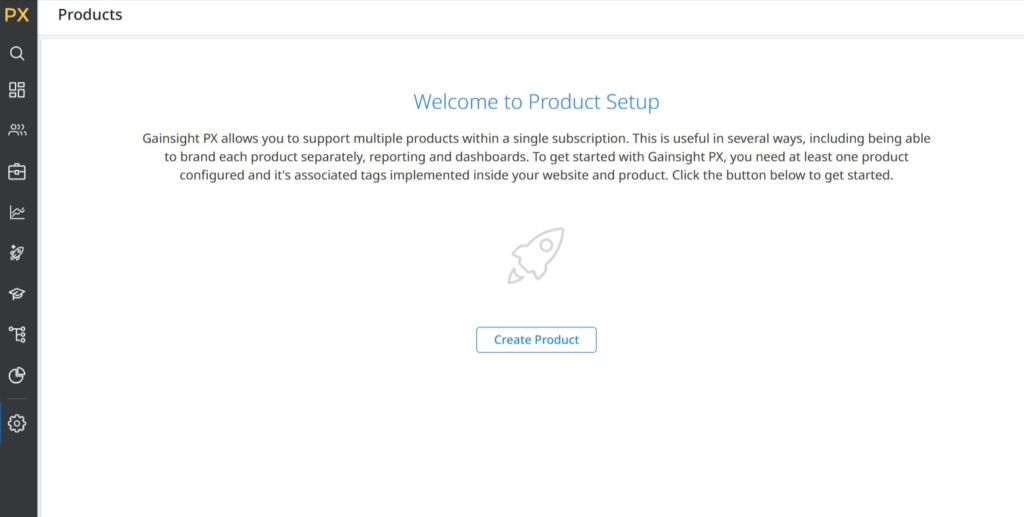
Must have features of onboarding automation tools
There are many onboarding automation tools available, so you may be confused about which one to choose.
Though the right tool will depend on your business goals and needs, here are the must-have features for any onboarding automation tool.
- Make sure the tool you choose isn’t limited to just product tours. Pick a tool that provides various UI patterns (modals, slideouts, banners, checklists, hotspots) to create beautiful welcome screens, and interactive walkthroughs to guide new customers and delight them from the very beginning.
- Look into getting decent segmentation capabilities based on in-app behavior and in-app experience engagement so you can trigger onboarding flows properly.
- An in-app help center is another feature that you should be looking for in an onboarding automation tool. With this, you can collect all your documentation files, tutorials, and videos in one place and offer on-demand support.
- Integration with 3rd party apps and tools so you can gain more insights and collect them in one place.
There you have it. These are the basic features that any solid onboarding automation tool should cover. Do your own research before buying a tool and make sure it’s aligned with your business goals.
GainsightPX features for onboarding automation
User onboarding is a critical process that helps set an initial impression of your platform. That’s why you need to ensure that you provide the right set of resources and hand-hold your users through this phase to get them accustomed to your platform.
GainsightPX offers a few features to help you get your user onboarding right:
- You can start by creating in-app guides and target them to new users to onboard them with ease. To create one, you can click on “Engagements” in the left sidebar and click on “Create.” You can select “Guide” among the options and add a description too.
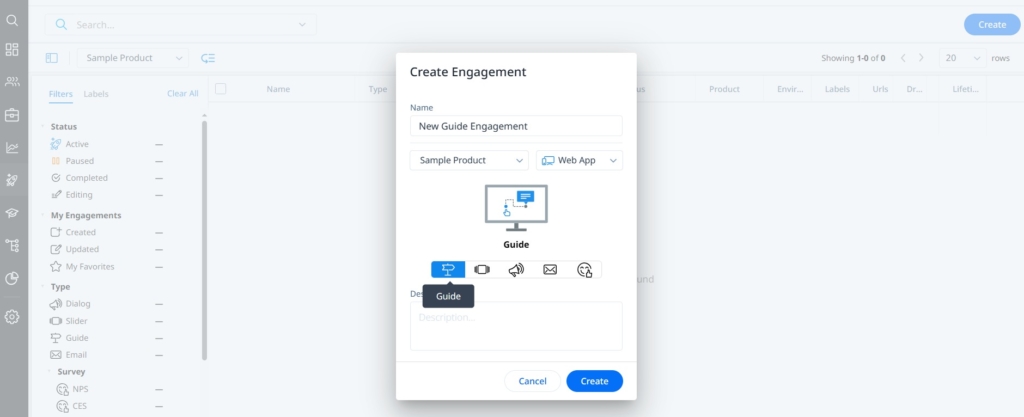
- GainsightPX gives you numerous segmenting rules based on personas, engagements, and systems to help you filter out users and show the in-app announcements to a targeted audience. You can then select a template and edit it to create your in-app announcement. GainsightPX offers tooltips, hotspots, dialog boxes, and more. Finally, you can schedule your in-app announcement and publish it.
- Create an extensive knowledge base with Knowledge center articles and bots. You can click on “Knowledge Center” in the left sidebar and select “Articles”.

- You can also create knowledge center bots that display a list of relevant knowledge center articles and external resources. These are essentially onboarding checklists and come in handy to help new users understand your platform. To create one, you can select “Bots” from the left sidebar and click on “Create.” You can then enter the name of the bot and describe it.
- You can select the audience by filtering it for various parameters and segment the users with multiple AND-OR rule logic filters. After that, you can add the content for your knowledge center bot. Finally, you can edit the look of the knowledge center bot and launch it.

GainsightPX’s user segmentation
To personalize your offerings, in-app messages, and other marketing campaigns, it’s important to segment your users well. Segmentation can help boost your product and feature adoption when combined with targeted messaging.
GainsightPX helps you segment your users in the following ways:
- You can then choose from 22 segmenting rules from personas, systems, and engagements. These rules can be combined using AND-OR operators to create a specific segment of your audience. The best bit here is that the segments also include survey responses. This way, you can target certain messages to those who have expressed dissatisfaction in surveys and vice-versa.

- The best part about segmenting here is that you can go very granular with it. You can narrow down your user segments to individual users based on their names, emails, etc. This makes it a great way to send specific messages to users and allows for greater personalization.
- Segmenting is also possible for knowledge center bots. However, you only get 4 rules for segmenting in this case, which can be slightly limiting.
GainsightPX’s onboarding checklist
Checklists are an excellent tool for simplifying user onboarding. They can nudge new users in the right direction as they navigate your product. Users can even monitor their progress through the checklist and determine their next steps.
You can create onboarding checklists using the knowledge center bots feature in GainsightPX.
- You can define the target audience for your checklist using the available rules and AND/OR rule logic filter. It’ll help you personalize the onboarding experience according to a user’s persona and demographics. However, the rules offered for knowledge center bots on GainsightPX are fairly limited compared to other in-app engagements.
- You can include in-app walkthroughs, surveys, knowledge base articles, and external links in the checklist. It’s very simple to add all these resources to your knowledge center bots too.
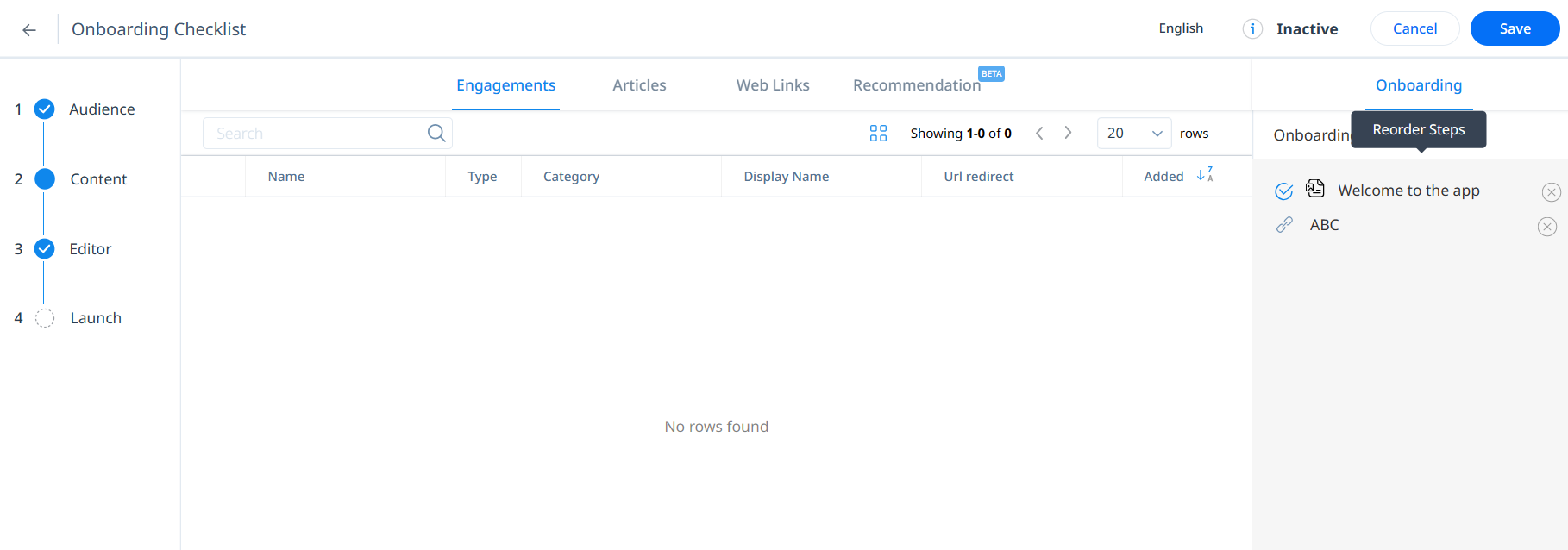
Onboarding checklist editor.
- The WYSIWYG editor lets you customize the look and feel of the checklist so that it aligns with your product’s branding. It’s worth noting here that you only get basic customization options by default. Advanced customization is only possible with CSS.
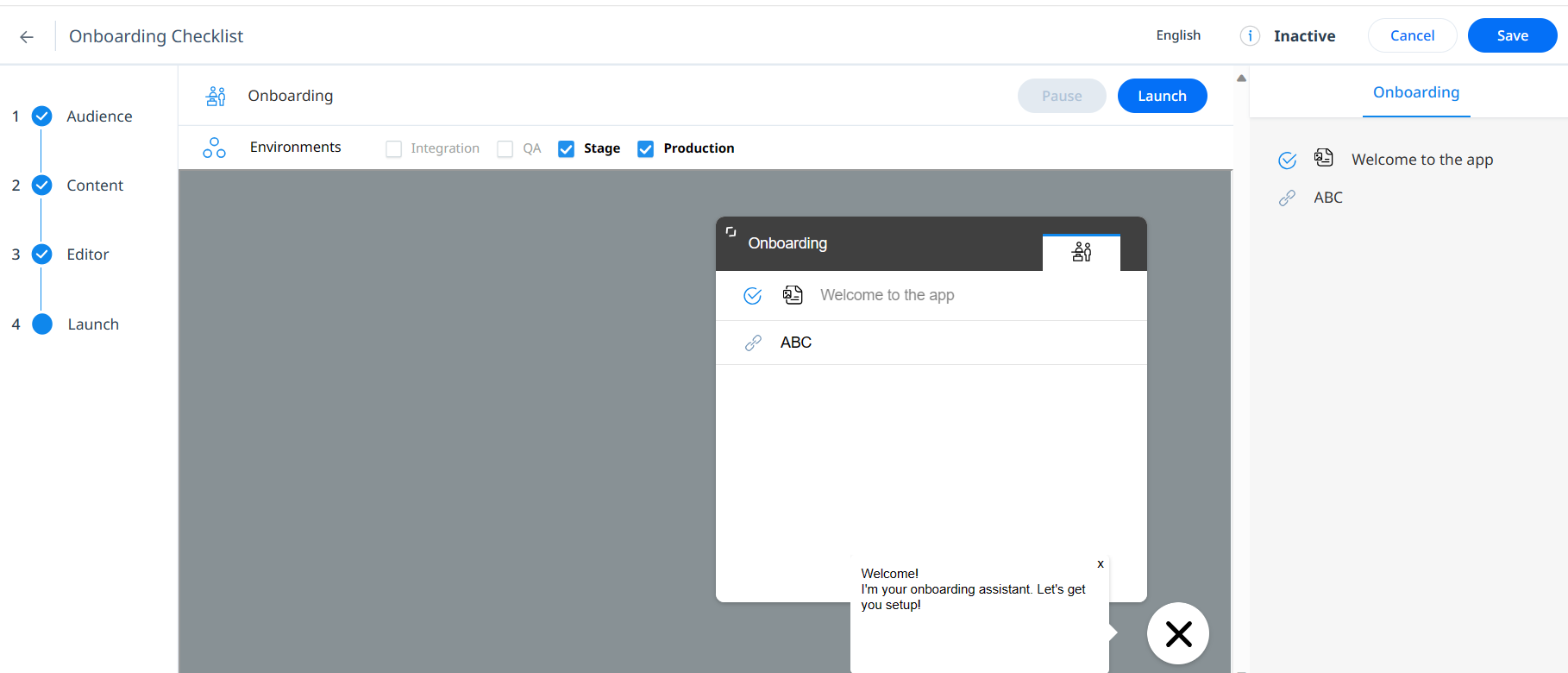
Checklist preview.
- GainsightPX gives you basic analytics related to the knowledge center bot in the Analytics section. You can use this feature to observe how new users interact with it. It’ll help you understand whether your onboarding experience is headed in the right direction.
GainsightPX’s self service support
As a product adoption platform, GainsightPX lets you integrate self-service support into your product. All you have to do is create and launch a knowledge center bot. Here’s how you can do that:
- You can build an in-app help center for self-service support and use AND/OR rule logic filters to refine your audience.
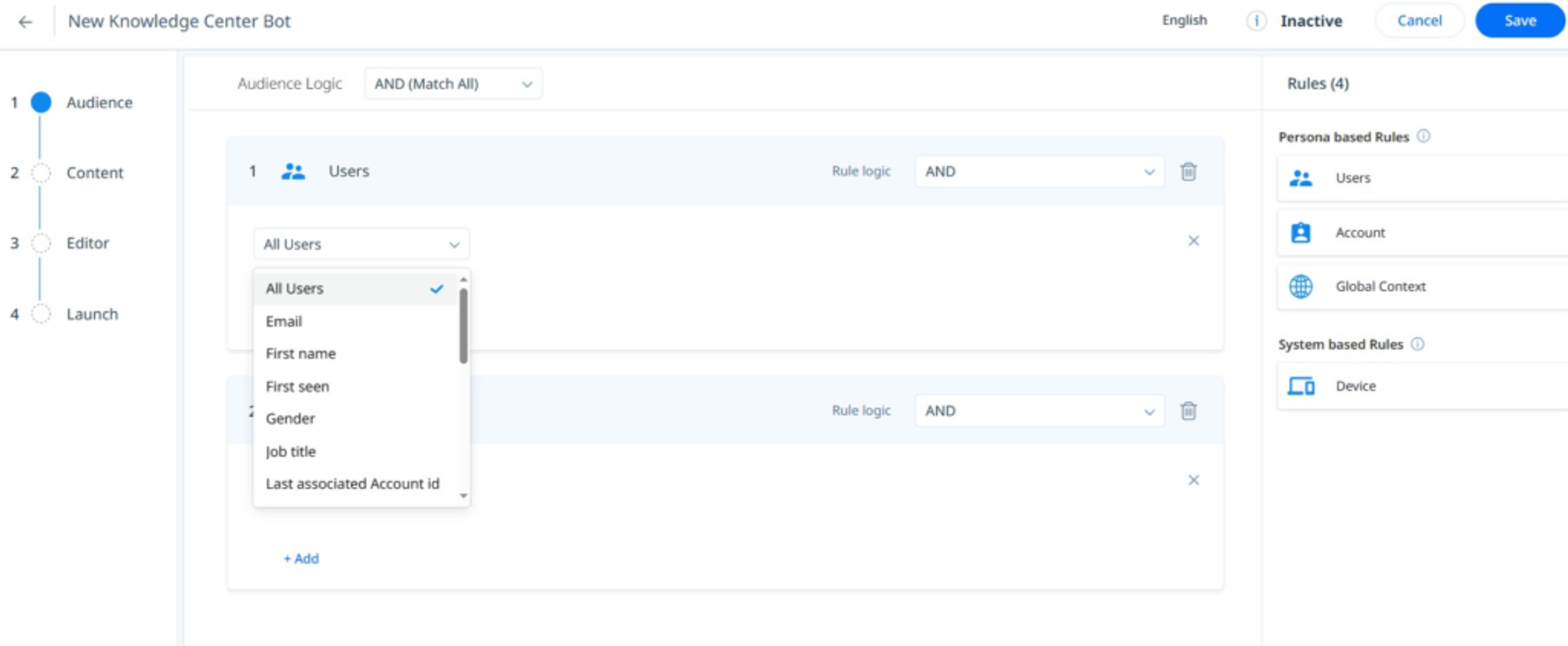
- You can include existing knowledge center articles, in-app engagements, and external resources. Additionally, you can highlight relevant content using the Recommendation feature. It’s an excellent tool to showcase important product tutorials, tooltips, and articles to handhold the user.

- You can also enable the feedback option in the Feedback tab to let users request new features, submit queries, or share their general experience of using your product.
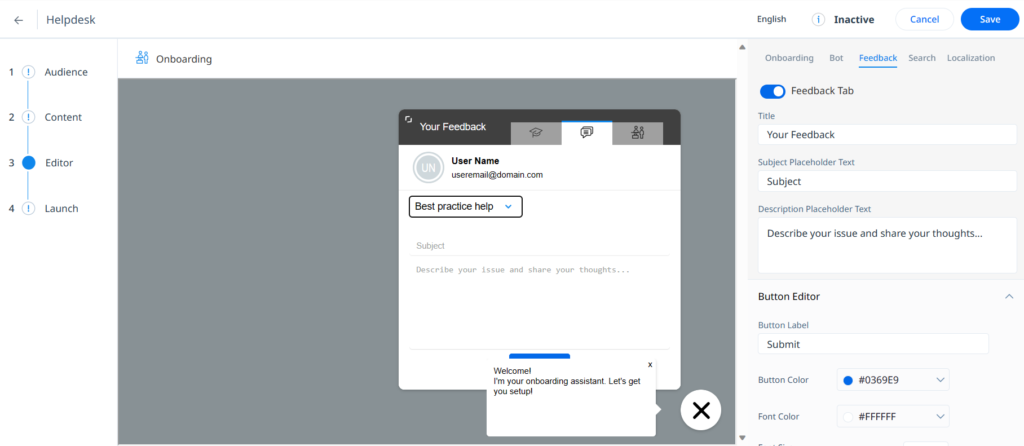
- Lastly, click Launch to get your always-available knowledge center bot up and running.
- Besides knowledge center bots, GainsightPX also lets you create walkthroughs, dialog boxes, and tooltips to help users get the hang of your product.
GainsightPX’s user journey mapping
A user journey map helps you dig deeper into the customer experience and visualize how users navigate your product. That, in turn, can help you identify points of friction where users are likely to churn.
GainsightPX lacks advanced features, such as session replays and heatmaps, which provide you with an accurate picture of the user journey. However, you can use the Path Analyzer feature in Analytics to get an idea of the different paths users take within your product. It comes in handy for identifying happy paths with higher conversion rates.
What are the pros and cons of GainsightPX?
GainsightPX’s pros
As a prominent product experience platform, GainsightPX offers several valuable features that can help you elevate your user experience. Let’s see why it stands out.
- Powerful segmentation: GainsightPX excels when it comes to segmentation. You can easily segment your audience into groups based on behavior, demographics, and other parameters to personalize their experience.
- Beginner-friendly: You have a WYSIWYG editor that helps you build product tours, in-app guides, and other UI elements that can help you engage your users and improve their experience. The ease of creating these makes the platform great for non-technical users.
- Powerful analytics: GainsightPX offers built-in analytics features that help you track key user engagement and behavior metrics. You can easily find trends and understand your customers better through the platform to elevate their experience further.
- Knowledge center: You can elevate user experience by leveraging the knowledge center bot offered by GainsightPX. It guides users on how to use your product by providing all the necessary links needed (including external ones). This, paired with knowledge center articles, makes for a great user experience.
- Easy feedback collection: GainsightPX makes it simple to create feedback surveys with multiple question types to gauge user requirements and feedback. You can create NPS, CES, Boolean, and numerous other types of surveys.
GainsightPX’s cons
While GainsightPX provides powerful product experience features, there are a few areas where it lags behind. Let’s take a look at them in detail.
- Long learning curve – GainsightPX offers some beginner-friendly features, but you need to spend some time using the tool before you can get the hang of it. The steep learning curve can make it difficult for beginners to use the platform to its fullest.
- Basic analytics – While the analytics feature offered by GainsightPX is powerful, it can get difficult to drill deeper into the data due to the numerous dashboards and widgets. It lacks predictive analytics features too.
- Limited integrations – GainsightPX offers a handful of integrations with third-party platforms. This makes it difficult to simplify workflow with your existing tech stack. It’d help if the number of integrations could be increased.
- In-app screen recording – GainsightPX doesn’t have an in-app screen recording feature that can help you see how users interact with your product. This feature could, otherwise, come in handy to understand how to elevate the user experience.
What do users say about GainsightPX?
GainsightPX has a great rating of 4.4 stars (out of 5) on G2. It also has a rating of 4 (out of 5) on Capterra. Users mostly praise how the platform offers numerous options for building engagements and understanding user behavior.
Here’s what a GainsightPX user had to say:
“GainsightPX has been a really powerful tool for engaging with our customers” There are a lot of options for how we can build engagements, the tool helps us fulfill a number of tasks concerning enhancing the Customer user experience and being able to communicate with them in a timely manner through an appropriate channel. Like most B2B we have an over-reliance on email as a comms channel for both product adoption, training, and wider marketing comms. Gainsight has helped us an entirely new channel to communicate with customers via. Rob W., Marketing Manager (Enterprise)
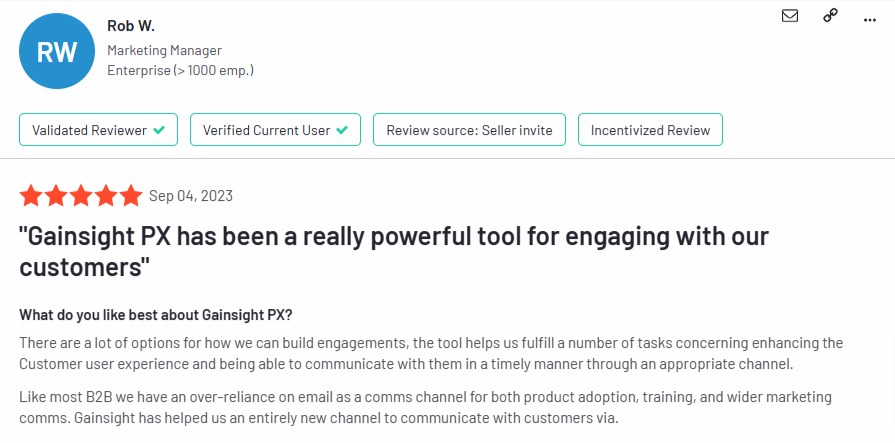 While a majority of users have given stellar ratings to GainsightPX across review sites, there are some who complain about its missing features and funnel functionality.
While a majority of users have given stellar ratings to GainsightPX across review sites, there are some who complain about its missing features and funnel functionality.
Here’s what one of the users had to say:
Previously I tried Hotjar and compared to it – there are some features missing. I really miss a real heatmap (the heatmap that Gainsight provides is not very graphical) or the possibility to see the recordings of my users actually using the platform (there is such an option of some sort of an addon to turn on but turning it on doesn’t really do anything to me and the recordings doesn’t show). I can create a funnel showing me how my users interacted with the website but only 10 positions can be present in one column. Therefore I have nine options showing and a big block named “Other”. Since the amount of “other” visited is pretty significant (often the biggest number on every step) it really affects the results. Pawel M., Trainer (Mid-Market)
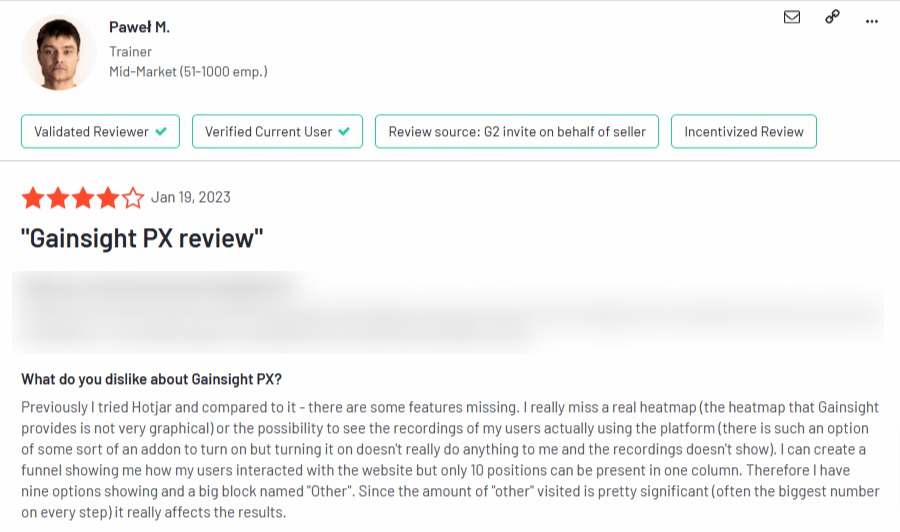
GainsightPX’s pricing
Pricing details for GainsightPX aren’t readily available. Instead, you have to request them by filling out a form. The final pricing of the platform will depend on your requirements.
That said, you can get a 30-day free trial of the platform with ease. You could also request a free demo of the platform.

3 Reasons why you might need a GainsightPX alternative
GainsightPX is one of the most prominent product experience platforms in the market. However, it does have its fair share of flaws.
Here are three main scenarios in which you would be better off choosing a GainsightPX alternative:
- You’re on a budget: GainsightPX isn’t the best option if you don’t have a big budget. While the pricing information is only available on request, it could cost you over $2500/month. This could be quite pricey if you’re on a budget and it’d be best to opt for a platform that’s more affordable.
- You want a more beginner-friendly platform: While GainsightPX does offer some beginner-friendly features like a WYSIWYG editor, it does have a long learning curve. If you have a non-technical background, you’re perhaps better off using a GainsightPX alternative.
- You need more extensive survey features: GainsightPX offers numerous types of surveys, including NPS. It also enables you to create multi-question survey engagements. But if you need more advanced features like behavior-based survey triggers and translations, you should opt for other platforms.
Userpilot – A better alternative for onboarding automation
 User onboarding is a crucial part of the customer journey as it speeds up the adoption process and increases retention rates. Onboarding is one of Userpilot’s core use cases along with product growth analytics and user feedback, so it has plenty of features that you can utilize.
User onboarding is a crucial part of the customer journey as it speeds up the adoption process and increases retention rates. Onboarding is one of Userpilot’s core use cases along with product growth analytics and user feedback, so it has plenty of features that you can utilize.
Here are some Userpilot features you can use when onboarding new users:
- No-code builder: Creating flows with Userpilot is as simple as installing the Chrome extension, selecting the UI patterns you’d like to use, and then editing the content/settings to suit your use case. You can also use templates to create modals, slideouts, tooltips, and driven actions.

- Native tooltips: Userpilot lets you create native tooltips that show up when users hover over an element or click on an information badge. Since these native tooltips attach to the element itself, they aren’t page-dependent and will show up on any screen where that element is visible.

- Funnel analytics: Userpilot’s advanced analytics lets you create funnel reports that track the onboarding journey. You can also add filters (like name, user ID, signup date, operating system, country, etc.) and monitor the total conversion rate from the first step of the funnel to the last.
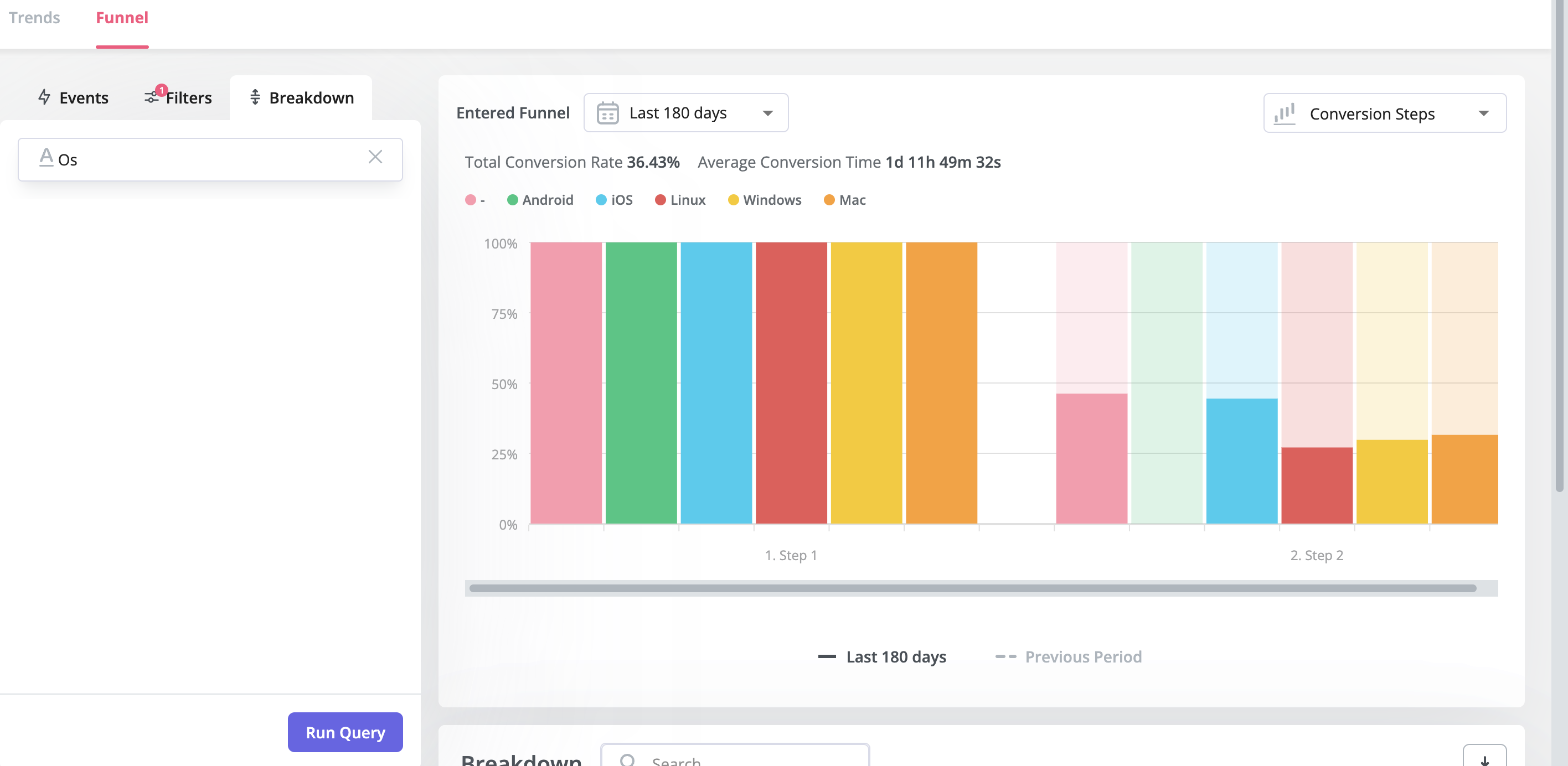
- User segmentation: Userpilot lets you segment users based on the device they’re using, where they’re located, their engagement data, or which NPS rating they selected on the latest survey. You can then filter your analytics dashboards to see which segments struggle with onboarding.

Userpilot’s user segmentation
User segmentation is essential for creating a personalized and contextual onboarding experience. Userpilot can segment users based on demographics, product usage data, NPS scores, and more. You can then trigger flows or filter analytics based on segments.
Here’s an overview of Userpilot’s customer segmentation capabilities:
- Segment conditions: Userpilot lets you form segments by adding different conditions like user data, company data, features and events, etc. You can then use these segments as analytics filters or flow triggers later on.
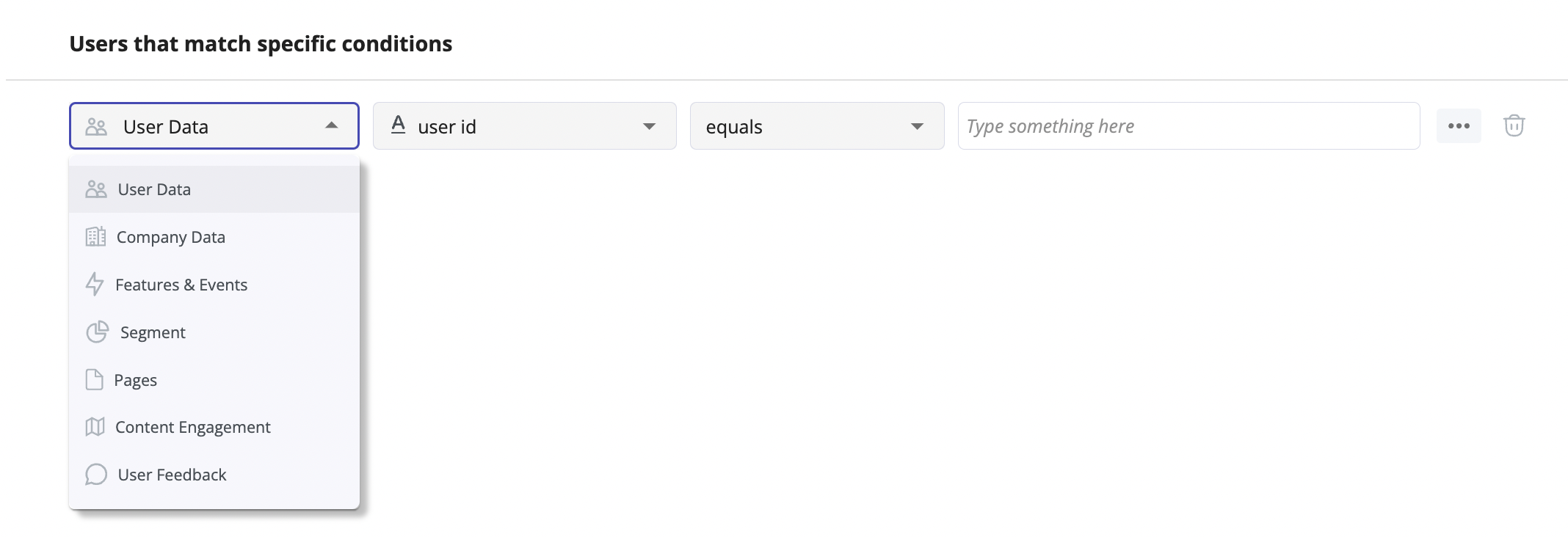
- Analytics filters: Userpilot’s product analytics and user insights dashboards can be filtered to only display data from specific segments (or companies). This will help you extract insights from certain cohorts and compare how adoption or activation varies from one segment to the next.

- Flow triggers: Userpilot’s audience settings let you trigger flows for specific segments or target users that meet certain conditions. You can combine this with page-specific or event-occurrence triggers to show relevant flows to the right users at the most contextual moments.

- External data: Userpilot integrates with tools like Amplitude, Google Analytics, Mixpanel, and Segment using a one-way integration. This means you can use the data inside Userpilot to build advanced segmentation and trigger contextual experiences. For more advanced use cases, the two-way integration with Hubspot lets you send and receive data, unlocking a full set of use cases.

Userpilot’s onboarding checklist
Onboarding checklists help new users learn about a product and reduce their time-to-value (TTV). Userpilot checklists can be created using the no-code builder, used to trigger specific actions, and tracked using the analytics dashboard to gauge overall engagement.
Here’s how you can use Userpilot to create an advanced onboarding checklist:
- No-code builder: Userpilot’s checklist creator lets you edit the content of checklists, add tasks, style icons, and configure the triggers for when your checklist should appear. You’ll also be able to choose from five widget icons (or upload your own) and recolor the widget to match your UI.

- Smart tasks: Checklist tasks can be set to trigger specific actions upon being completed, such as redirecting a user to a different page, launching an in-app flow, or running a custom JavaScript function. You can also set the conditions for when a task and action will be marked as complete.

- Checklist analytics: The Checklists dashboard shows you all relevant metrics. These include the number of live checklists you have, how many views they’ve gotten, and how many have been completed. You can also sort these analytics by segment or time period to identify trends.
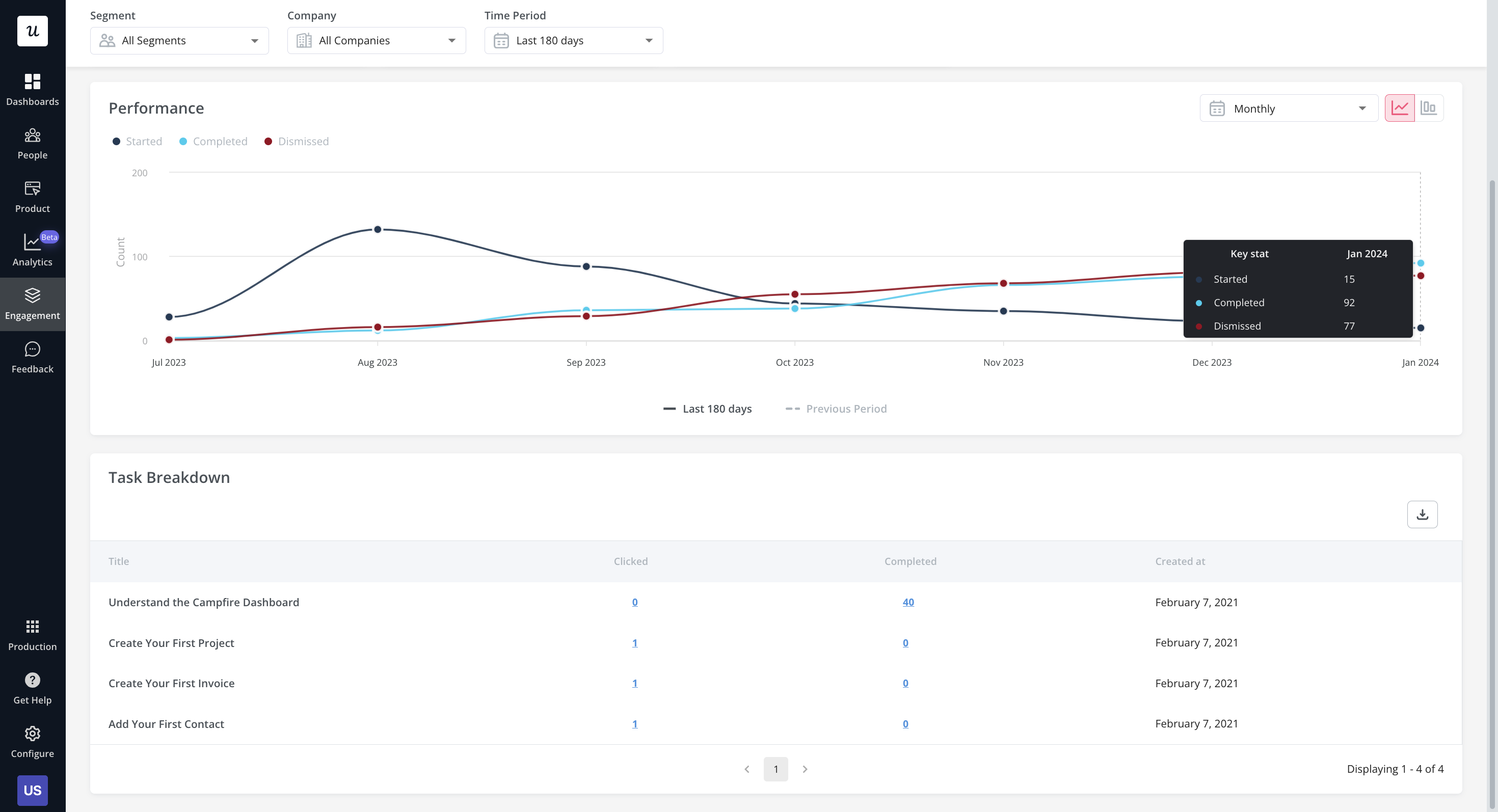
Userpilot’s self service support
Self-service support helps users solve problems themselves instead of having to reach out to a representative. Userpilot’s no-code resource center makes onboarding guides and product documentation easily accessible to users from within your product.
Here’s how you can use Userpilot to create a self-service customer experience:
- No-code builder: Userpilot’s no-code resource center lets you add modules without writing a single line of code. Module options include links, videos, flows, custom JavaScript functions, and checklists. You can also group modules into sections to help users navigate the resource center.
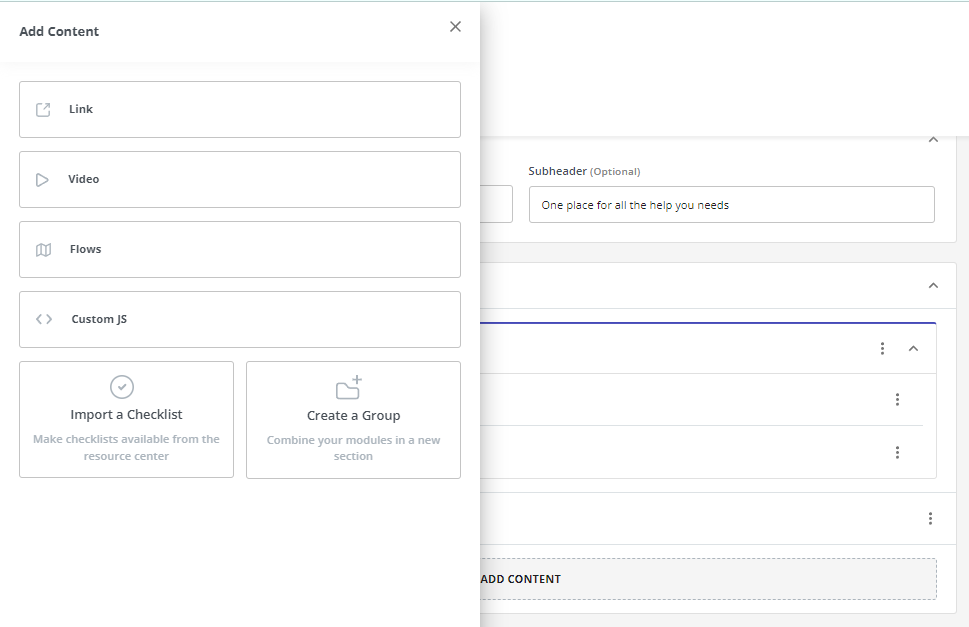
- Module segmentation: Userpilot’s segmentation settings let you hide or show specific modules within your resource center based on audience settings. This makes it possible to create modules for different user segments and hide resources that aren’t relevant to other users.
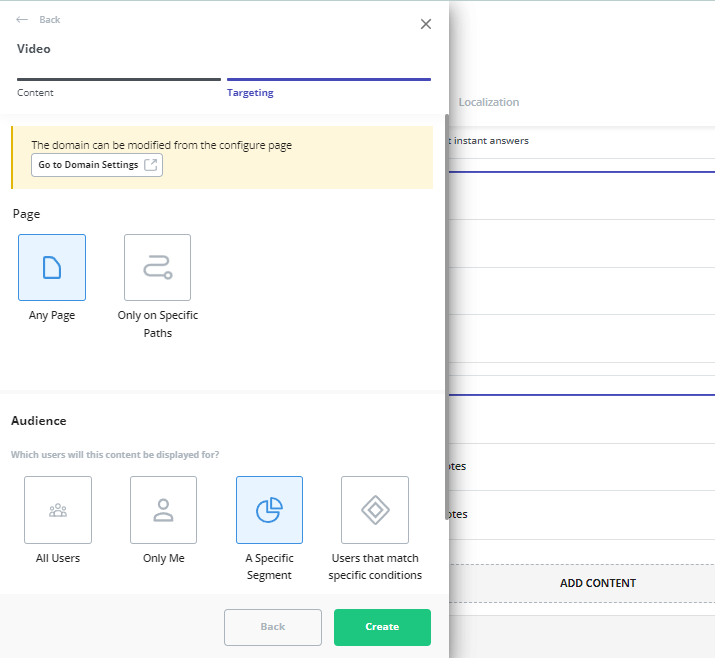
- Resource center analytics dashboard: The dedicated analytics dashboard helps you see how many unique visitors your resource center gets, how many modules have been clicked, and the overall click rate across your user base. This will make it easier to gauge resource center performance.

Userpilot’s user journey mapping
User journey mapping helps you visualize all the interactions between users and your product as they try to achieve a particular goal. Userpilot’s detailed user analytics and funnel/trend reports help you track customers as they progress through different stages of their journey.
Here are the Userpilot features you can use for user journey mapping:
- User analytics: The Users dashboard provides detailed analytics of your entire customer base. You’ll be able to sort by segment, company, or time period and add multiple filters to help you narrow results. You can also perform bulk actions and export user data in a CSV format.
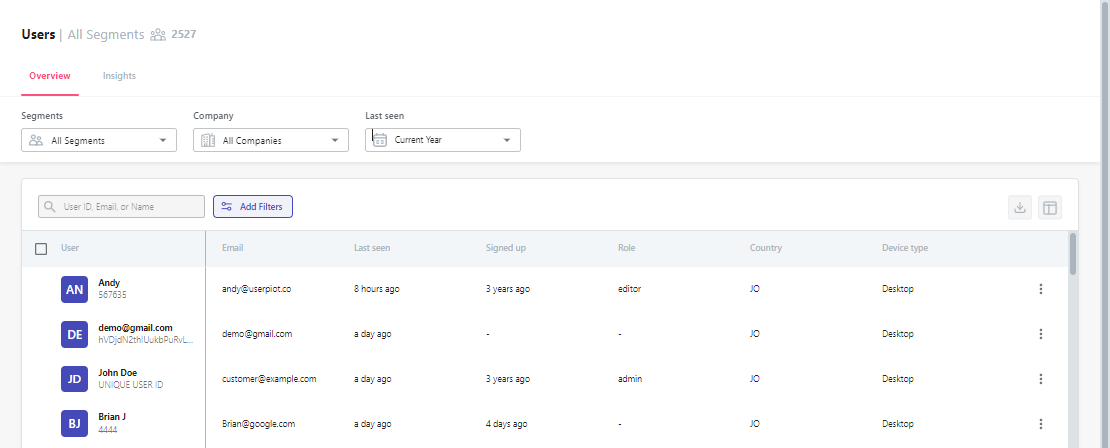
- Funnel reports: These reports help you visualize the user journey map by showing which stage, page, or action most users get stuck on. You’ll also be able to view breakdowns so you can see how the user journey changes depending on which OS, browser, or device type a user is on.
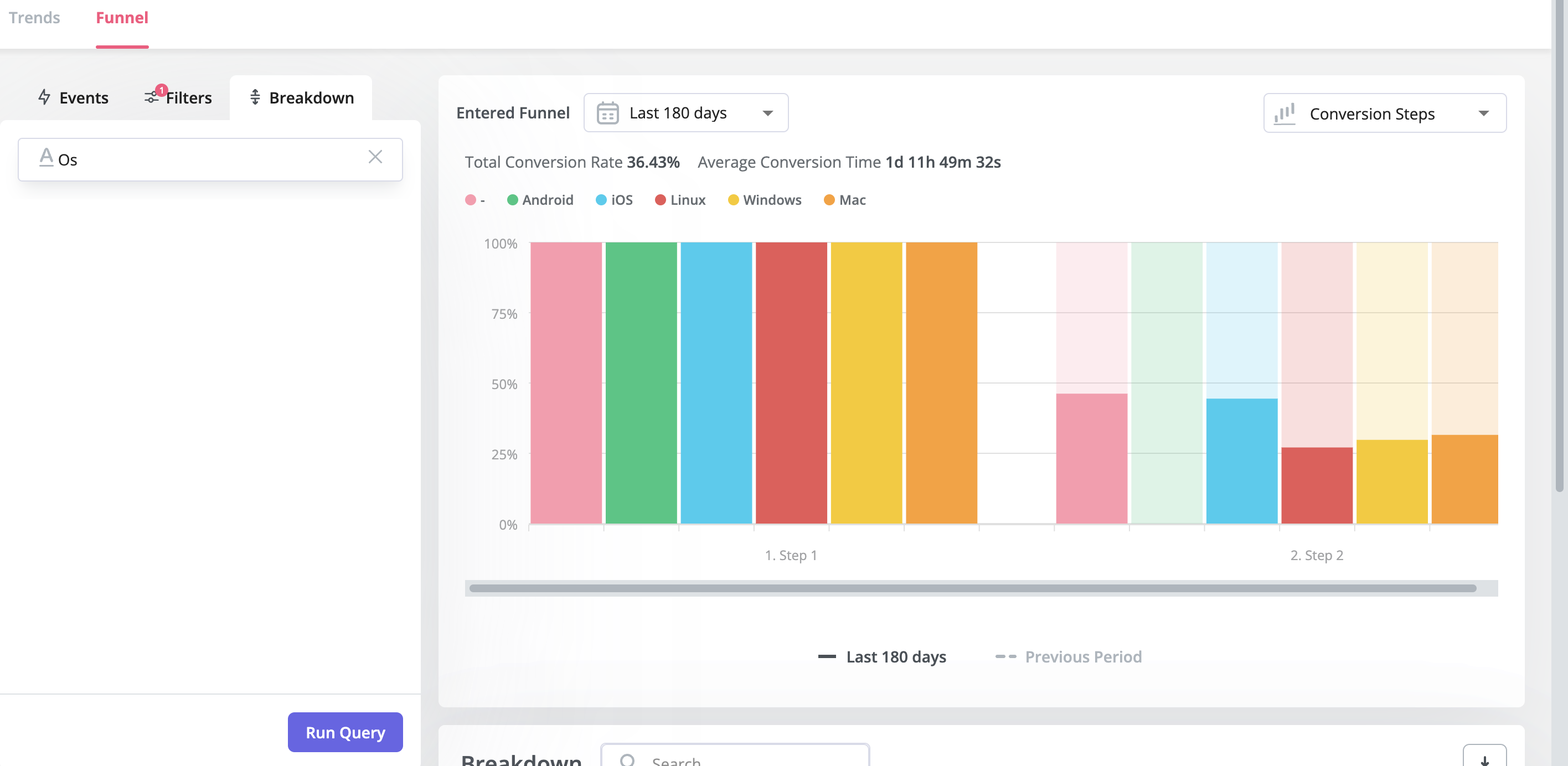
- Trend reports: Userpilot’s trend reports offer behavioral insights such as how often users perform a specific action, the number of unique users who take that action, and where in the user journey these actions occur. You can also create custom metrics and build your own charts.

What are the pros and cons of Userpilot?
Userpilot pros
As a full-suite digital adoption platform, Userpilot has all the features you need to onboard users, track analytics, and gather feedback from customers without writing a single line of code. Here are a few pros of using Userpilot as your product growth solution:
- No-code builder: Userpilot’s Chrome extension lets you build flows, add UI elements, and tag features without writing a single line of code.
- UI patterns: There are plenty of UI patterns to choose from when using Userpilot, such as hotspots, tooltips, banners, slideouts, modals, and more!
- Startup-friendly: Userpilot’s entry-level plan gives you access to all available UI patterns so you can hit the ground running.
- Walkthroughs and flows: Build engaging interactive walkthroughs and personalized onboarding flows that target specific segments of your user base.
- Self-service support: Build an in-app resource center to help users solve problems, customize its appearance to align it with your brand, and insert various types of content (videos, flows, or chatbots) to keep your customers satisfied.
- A/B testing: Userpilot’s built-in A/B testing capabilities will help you split-test flows, iterate on the best-performing variants, and continually optimize based on user behavior.
- Feedback collection: Userpilot has built-in NPS surveys with its own unified analytics dashboard and response tagging to help you retarget users. There are other survey types to choose from and you can even create your own custom survey.
- Survey templates: There are 14 survey templates to choose from so you can gather feedback on specific features or run customer satisfaction benchmarking surveys like CSAT and CES.
- Advanced analytics: Userpilot lets you analyze product usage data, monitor engagement on all in-app flows, and use the data to create user segments that are based on behaviors instead of demographics.
- Event tracking: Userpilot’s no-code event tracking lets you tag UI interactions (hovers, clicks, or form fills) and group them into a custom event that reflects feature usage.
- Third-party integrations: Userpilot has built-in integrations with tools like Amplitude, Mixpanel, Kissmetrics, Segment, Heap, HubSpot, Intercom, Google Analytics, and Google Tag Manager so you can share data between all the solutions in your tech stack.
Userpilot’s cons
Of course, no tool is perfect and there are a few cons to consider before choosing Userpilot as your user onboarding or product growth solution:
- Employee onboarding: Currently, Userpilot only supports in-app customer onboarding.
- Mobile apps: Userpilot doesn’t have any mobile compatibility which could make it difficult for developers with cross-platform applications to create a consistent user experience for both versions of their product.
- Freemium plan: There’s no freemium Userpilot plan so those bootstrapping their startup and need sub-$100 solutions should consider more affordable onboarding platforms like UserGuiding or Product Fruits.
What do users say about Userpilot?
Most users laud Userpilot for its versatile feature set, ease of use, and responsive support team:
I recently had the pleasure of using Userpilot, and I must say it exceeded all my expectations. As a product manager, I’m always on the lookout for tools that can enhance user onboarding and improve overall user experience. Userpilot not only delivered on these fronts but also went above and beyond with its impressive new features, unparalleled ease of use, and truly exceptional customer support.
What truly sets Userpilot apart is its outstanding customer support. Throughout my journey with Userpilot, the support team has been responsive, knowledgeable, and genuinely dedicated to helping me succeed. Whenever I had a question or encountered an issue, their support team was always there to assist promptly, going above and beyond to ensure my concerns were addressed effectively.

Source: G2.
Of course, other users are also kind enough to share constructive criticism regarding specific features like event tracking filters:
“The filtration while analyzing specific events is a little confusing. Understanding of custom properties and data management configuration could have been more organised.”

Source: G2.
Userpilot’s pricing
Userpilot’s transparent pricing ranges from $249/month on the entry-level end to an Enterprise tier for larger companies.
Furthermore, Userpilot’s entry-level plan includes access to all UI patterns and should include everything that most mid-market SaaS businesses need to get started.

Userpilot has three paid plans to choose from:
- Starter: The entry-level Starter plan starts at $249/month and includes features like segmentation, product analytics, reporting, user engagement, NPS feedback, and customization.
- Growth: The Growth plan starts at $749/month and includes features like resource centers, advanced event-based triggers, unlimited feature tagging, AI-powered content localization, EU hosting options, and a dedicated customer success manager.
- Enterprise: The Enterprise plan uses custom pricing and includes all the features from Starter + Growth plus custom roles/permissions, access to premium integrations, priority support, custom contract, SLA, SAML SSO, activity logs, security audit, and compliance (SOC 2/GDPR).
Conclusion
There you have it.
It should be easier now to make an informed decision whether GainsightPX is your go-to option for onboarding automation. Ultimately, the best choice will depend on your product and current needs.
If you’re looking for a better alternative to GainsightPX for onboarding automation, book a Userpilot demo today to experience firsthand how it can enhance your user experience and drive product growth!
![]()
Looking for a Better Alternative for Onboarding Automation? Try Userpilot


